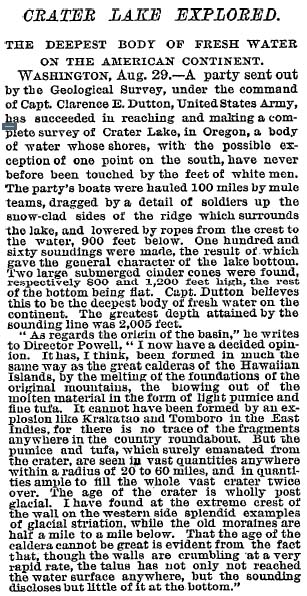Crater Lake Explored – The Deepest Body of Fresh Water on the American Continent
New York Times
New York, New York
Aug. 30, 1886
 |
Washington, Aug. 29.- A party sent out by the Geological Survey, under the command of Capt. Clarence E. Dutton, United States Army, has succeeded in reaching and making a complete survey of Crater Lake, in Oregon, a body of water whose shores, with the possible exception of one point on the south, have never before been touched by the feet of white men. The party’s boats were hauled 100 miles by mule teams, dragged by a detail of soldiers up the snow-clad sides of the ridge which surrounds the lake, and lowered by ropes from the crest to the water, 900 feet below. One hundred and sixty soundings were made, the result of which gave the general character of the lake bottom. two large submerged cinder cones were found, respectively 800 and 1,200 feet high, the rest of the bottom being flat. Capt. Dutton believes this to be the deepest body of fresh water on the continent. The greatest depth attained by the sounding line was 2,005 feet.
“As regards the origin of the basin,” he writes to Director Powell,” I now have a decided opinion. It has, I think, been formed in much the same way as the great calderas of the Hawaiian Islands, by the melting of the foundations of the original mountains, the blowing out of the molten material in the form of light pumice and fine tufa. It cannot have formed by an explosion like Krakatoa and Tomboro in the East Indies, for there is no trace of the fragments anywhere in the country roundabout. But the pumice and tufa, which surely emanated from within a radius of 20 to 60 miles, and in quantities ample to fill the whole vast crater twice over. The age of the crater is wholly post glacial. I have found at the extreme crest of the wall on the western side splendid examples of glacial striation, while the old moraines are half a mile to a mile below. That the age of the caldera cannot be great is evident from the fact that, though the walls are crumbling at a very rapid rate, the talus has not only not reached the water surface anywhere, but the sounding discloses but little of it at the bottom.”
Other pages in this section

